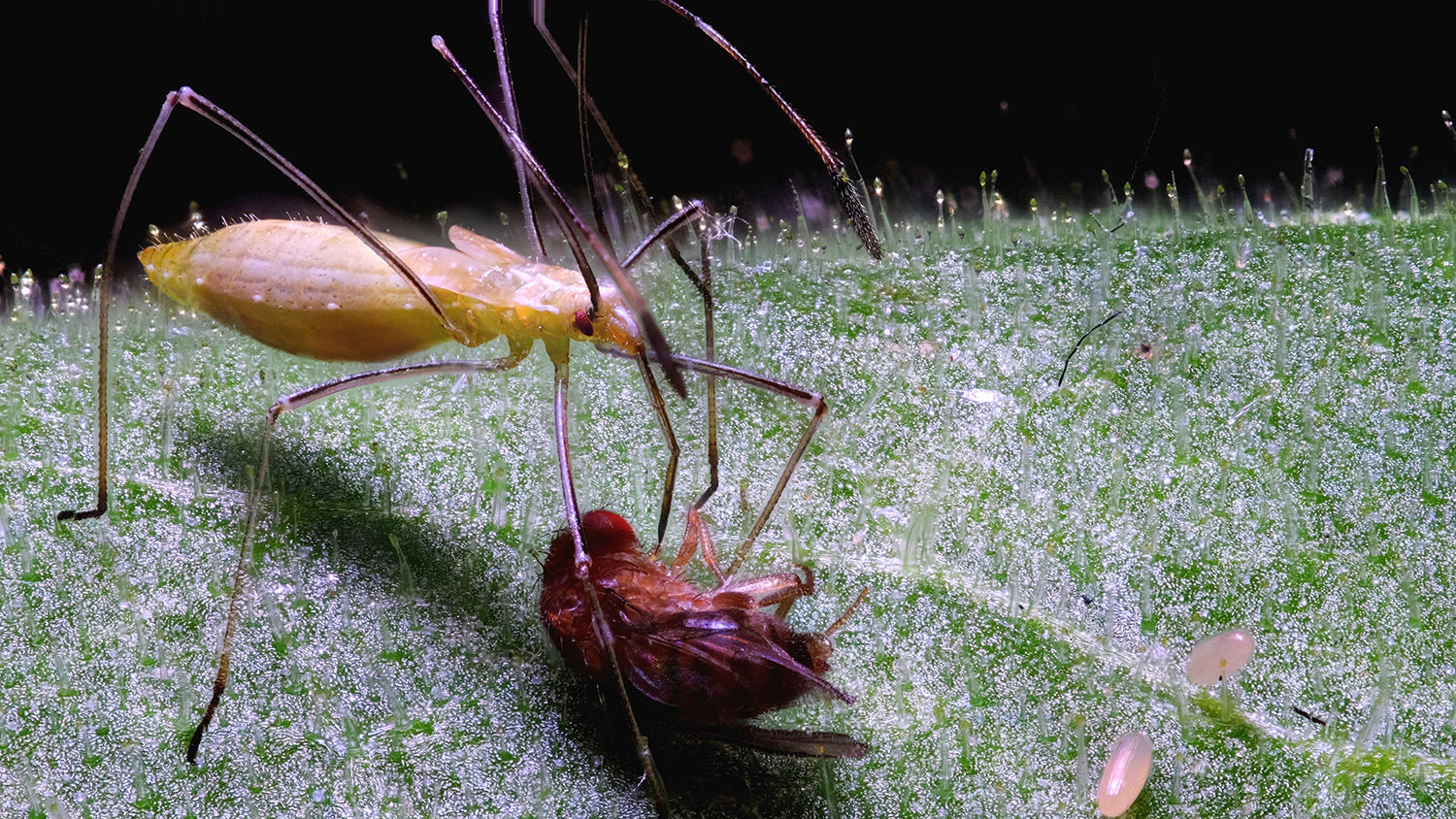Tobacco Plant ‘Stickiness’ Aids Helpful Insects, Plant Health

For Immediate Release
Researchers at North Carolina State University have shown that “sticky” hairlike structures on tobacco leaves can help attract beneficial insects that scavenge on other insects trapped on the leaves, increasing leaf yield and reducing pest damage to plant structures.
In a study examining pests of tobacco plants and opportunistic insects that eat the pests, researchers show that sticky glandular trichomes on tobacco leaves trap insects that aren’t adapted to interacting with perilous plant surfaces. The trapped insects perish and then become food for the spined stilt bug (Jalysus wickhami) – a small but long-legged insect predator that has a beneficial relationship with tobacco plants.
Tobacco plants provide a trapped-insect buffet that spined stilt bugs are more than happy to feast upon, which helps protect the plant from pest infestation and damage. Better still, the spined stilt bug – which uses its long legs as leverage to navigate across the sticky parts of tobacco leaves to reach its bug banquet – isn’t harmful to tobacco plants, researchers say, although it drinks some sap from tobacco plants to stay hydrated between pest meals.
“A sticky plant isn’t a dead end for all insects; some actually prefer sticky plants and take advantage of the difficult plant surface,” said Peter Nelson, an NC State Ph.D. graduate and lead author of a paper describing the study.
“By taking a closer look at how insects interact with plants, we might be able to take advantage of unique interactions for pest management,” Nelson added. “Our review of the literature found that over 25 economically important plants have sticky surfaces that trap insects and might benefit from the same type of interaction with predatory arthropods.”
“This is a mutualistic relationship previously unrecognized on domesticated tobacco plants,” said Clyde Sorenson, Alumni Association Distinguished Undergraduate Professor of Entomology at NC State and corresponding author of the paper. “The academic literature shows a number of wild flowers with similar symbiotic relationships with predators to reduce damage to the plant, but tobacco is the first economically important plant to show this mutualistic relationship.”
In the study, the abundance of spined stilt bugs grew when researchers added dead fruit flies (Drosophila melanogaster) to the leaves of tobacco plants in greenhouse and field settings. Increased leaf yield – the primary economic consideration for tobacco farmers – and less damage to tobacco plant structures resulted when additional fruit flies were added to leaves.
The study also showed that insecticide use did not affect pest entrapment by sticky glandular trichomes. Plants treated with imidacloprid, a common tobacco insecticide, had fewer spined stilt bugs than untreated plants, but that did not significantly affect pest densities or plant health.
Surprisingly, the study showed that densities of pests like the tobacco budworm on tobacco leaves did not decrease, even though more spined stilt bugs were present.
“We’re not completely sure about why this counterintuitive finding occurred, although one hypothesis is that the increased number of predator stilt bugs may trigger a behavioral response in the tobacco budworm and other pests to feed less on tobacco plants,” Sorenson said.
Sorenson said the results could lead to further improvement or manipulation of glandular trichomes.
“We don’t expect farmers to throw dead fruit flies on 40 acres of a tobacco crop, but recognizing the effects of beneficial insects and how these mutually beneficial relationships work is important,” he said. “Plus, these types of effects may occur in other economically important crops with glandular trichomes, like tomatoes.”
The study appears in Biological Control. Hannah Burrack, professor of entomology and extension specialist, co-authored the paper. The North Carolina Tobacco Research Commission funded the study.
– kulikowski –
Note to editors: An abstract of the paper follows.
“Arthropod entrapment increases specialist predators on a sticky crop and reduces damage”
Authors: Peter Nelson, Hannah Burrack and Clyde Sorenson, North Carolina State University
Published: Online August 2019 in Biological Control
DOI: 10.1016/j.biocontrol.2019.104021
Abstract: Maximizing plant defensive strategies is integral to effective integrated pest management. Direct defenses, in the form of chemical and morphological components that inhibit pest damage, underlie host plant resistance, while indirect defenses, including food provisioning and semiochemical production, improve biological control. Interactions between the two defensive strategies may be disruptive, complementary, or synergistic and are an important consideration for effective pest management programs. Glandular trichomes are plant structures that inhibit or entrap arthropods, protecting plants against herbivores, potentially at the cost of reducing natural enemy efficacy. Glandular trichomes may also contribute to indirect defense, as predatory arthropods adapted to “sticky” surfaces scavenge on entrapped arthropods. Scavenging increases predator abundance and reduces plant damage; this protective mutualism has been demonstrated with multiple sticky wild flowers but has not been assessed in an economically important plant, such as tobacco. We augmented dead arthropods (carrion) on tobacco plants grown under conditions similar to commercial production and assessed tri-trophic interactions. Carrion augmentation increased predator abundance, reduced damage to reproductive structures, and increased leaf yield, but did not reduce pest densities. We determined that systemic insecticide use did not affect carrion entrapment on tobacco plants. Review of the literature revealed that a variety of economically important plants entrap arthropods on their surfaces, indicating this mutualism has potential for development into a conservation biological control tactic.
- Categories:


